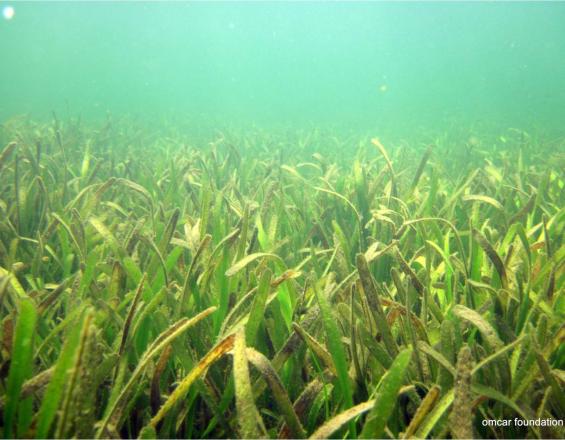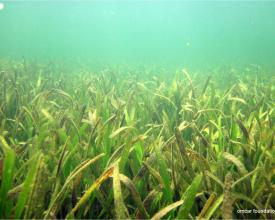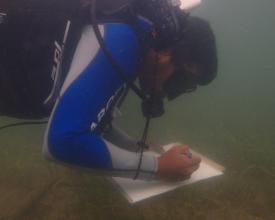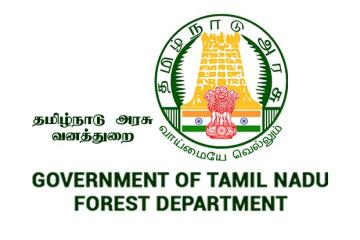
Dugongo - Conservación de los pastos marinos en la bahía de Palk (India)

La Fundación OMCAR se creó para la conservación de los dugongos y los hábitats costeros de la bahía de Palk. Nuestra organización cartografió las praderas marinas mediante tecnología acústica, documentó el varamiento de animales durante más de una década para concienciar a los pescadores y desarrolló la política en el Gobierno mediante nuestras publicaciones científicas y apoyo técnico. El Departamento Forestal de Tamil Nadu formó grupos de rescate y liberación de dugongos (amigos de los dugongos) a nivel de base con el Wild Life Institute of India y OMCAR, que ayudaron a rescatar y liberar a los dugongos de las redes de pesca. Además, omcar desarrolló métodos de restauración de pastos marinos ecológicos y de bajo coste utilizando cuerdas de bambú y coco, que se están adaptando para reproducirlos a gran escala en el futuro. Como resultado del esfuerzo continuo, la primera orden gubernamental de reserva para la conservación de dugongos de la India se ha publicado a principios de 2022.
Contexto
Défis à relever
1. Falta de información de referencia sobre la población de dugongos y sus hábitats de alimentación (praderas marinas). Por ello, trabajamos más de una década en la investigación y documentación.
2. Falta de concienciación entre las partes interesadas sobre la conservación de los dugongos a todos los niveles, por lo que documentamos periódicamente las muertes de dugongos, los varamientos y los animales asociados a las praderas marinas y creamos conciencia en pueblos, escuelas y escribiendo artículos de divulgación en periódicos, sitios web y medios sociales.
3. En Palk Bay no había grupos de conservación de base, por lo que en los últimos cinco años el Departamento Forestal de Tamil Nadu, el Instituto de Vida Silvestre de la India y la OMCAR han creado grupos de este tipo, lo que ha permitido rescatar y liberar dugongos.
Ubicación
Procesar
Resumen del proceso
La concienciación de los pescadores (bloque 1) ayudó a nuestra organización a establecer una buena relación con ellos. Así, participaron en nuestra cartografía de las praderas marinas (bloque de construcción 2) y también desarrollaron un método de restauración de las praderas marinas respetuoso con el medio ambiente y de bajo coste (bloque de construcción 3) y de conservación del dugongo. Tardamos casi diez años en construir los tres primeros bloques. Después, OMCAR impartió formación técnica para el personal gubernamental (bloque de construcción 4) sobre la restauración de las praderas marinas y el rescate y liberación de dugongos y también organiza a los pescadores locales para el rescate y liberación de dugongos a través de redes (bloque de construcción 5). Como siguiente paso, nuestra organización ha estado trabajando con el Departamento Forestal de Tamil Nadu para la declaración de la conservación del dugongo en la reserva de Palk Bay, que está en curso.
Bloques de construcción
Sensibilización sobre la conservación marina en la bahía de Palk (2007 - 2022)
En 2007, se recorrieron 600 km en kayak de mar en solitario a lo largo de la costa de Tamil Nadu (costa sudoriental de la India) para concienciar sobre la conservación de los ecosistemas marinos locales, incluidos los dugongos, las praderas marinas, los arrecifes de coral y los manglares. En los últimos 15 años, unas 40000 personas, entre escolares, universitarios, pescadores y funcionarios, han asistido a nuestras actividades de concienciación sobre la conservación marina a través de música folclórica, programas educativos de concienciación a nivel escolar, concursos, seminarios, formación, excursiones y distribución de material de concienciación. Esta concienciación continua a nivel local y subnacional ha creado lazos con las partes interesadas en el rescate y liberación de dugongos, y en la cartografía y restauración de praderas marinas.
Factores facilitadores
- Capacitación del personal y los voluntarios de la comunidad local.
- Produjimos un amplio conjunto de fotos y vídeos submarinos de hábitats de pastos marinos y dugongos de la costa local.
- En 2011 creamos nuestro centro de educación marina "Palk Bay Environmental Education Centre".
- Hemos distribuido más de 25.000 materiales de concienciación a las partes interesadas en los últimos 15 años.
- Organizamos (seminarios/formación/campamentos/excursiones) sin ánimo de lucro para escolares, universitarios, pescadores y funcionarios públicos.
Lección aprendida
- Los esfuerzos continuados durante unos años en la concienciación sobre la conservación de la naturaleza pueden cambiar la mentalidad y el apoyo de las partes interesadas locales.
- Producir nuestras fotos y vídeos y compartir nuestra experiencia sobre el terreno en el rescate y liberación de dugongos y la restauración de praderas marinas son herramientas importantes.
- El desarrollo de las capacidades del personal y los voluntarios de la comunidad local ayudó a difundir la concienciación durante más de una década de forma continuada.
- Instalar nuestro campus de educación marina cerca de la zona objetivo (la playa de praderas marinas) es una gran ventaja, que ofrece una exposición directa a los visitantes.
Recursos
Encuesta participativa para cartografiar las praderas marinas del norte de la bahía de Palk (2010 - 2017)
Antes de este estudio, no se disponía de datos científicos precisos sobre la extensión de las praderas marinas en el norte de la bahía de Palk. Los preparativos comenzaron en 2010, y el estudio propiamente dicho se inició en 2013 y se publicó en 2018. Tuvimos que enfrentarnos a problemas relacionados con la financiación, la logística y la forma de crear conocimientos técnicos dentro de nuestra organización. Debido a la mala calidad del agua, era difícil cartografiar las praderas marinas mediante imágenes por satélite. Por ello, OMCAR construyó un barco de investigación (un barco de pesca modificado), desarrolló conocimientos en SIG y métodos acústicos, y equipo de buceo de 2010 a 2013. Con la financiación de NRDMS, DST, Gobierno de la India, OMCAR comenzó a realizar el estudio acústico en aguas poco profundas cercanas a la costa en el norte de Palk Bay para proponer el sitio como una reserva de conservación. Este fue el primer intento de este tipo para estudiar las praderas marinas utilizando la tecnología acústica en la India. Los informes finales se presentaron al Gobierno y también se publicaron en 2018. Este estudio de referencia reveló la distribución de las praderas marinas en la "reserva de conservación del dugongo" hasta 35.000 hectáreas del norte de la bahía de Palk, por lo que se ha seleccionado un área de 500 kilómetros cuadrados dentro y alrededor de esta pradera marina para ser declarada como "Reserva de Conservación del Dugongo" sobre la base de esta investigación del Gobierno.
Factores facilitadores
Nuestro equipo está formado por un biólogo marino (fundador de OMCAR), personal y voluntarios de la comunidad local. Esto nos permitió planificar los métodos de estudio de las praderas marinas utilizando tanto conocimientos científicos como tradicionales.
Se montaron dispositivos de navegación de bajo coste para que el barco navegara perpendicular a la costa a lo largo de los transectos.
Los pescadores locales que asistieron a nuestra formación nos ayudaron con sus conocimientos tradicionales a planificar los meses y el tiempo adecuados para llevar a cabo el estudio de las praderas marinas.
Lección aprendida
- El estudio acústico de las praderas marinas puede proporcionar información precisa y local sobre su distribución para planificar su conservación.
- Es importante contar con la participación y el apoyo de la población local, lo que contribuirá a la seguridad del equipo encargado del estudio y a la selección de los meses y el momento adecuados para realizarlo.
- Dado que los resultados son importantes como prueba de la superficie total de praderas marinas para declarar el lugar protegido, es esencial contar con conocimientos técnicos y personal especializado.
- La formación y capacitación de voluntarios locales de la comunidad pesquera es importante para los estudios participativos de las praderas marinas.
Desarrollo de un método de restauración de las praderas marinas participativo, ecológico y de bajo coste (2016 - 2022)
La restauración de las praderas marinas es diferente de la restauración de las plantas terrestres, ya que necesita trabajar el ecosistema submarino. Las praderas marinas se reproducen por vía sexual y vegetativa. En la restauración de las praderas marinas, los brotes de praderas marinas se retiraban del lugar donante y se trasplantaban a los lugares degradados. Ya existían métodos establecidos obtenidos de publicaciones científicas que utilizaban marcos de PVC de 1m2 para trasplantar las praderas marinas. Aunque este método tiene éxito, decidimos no utilizar los plásticos de PVC que deben fijarse permanentemente en el fondo marino para la restauración de las praderas marinas. Por ello, la OMCAR debatió con los pescadores locales el desarrollo de un método ecológico y de bajo coste para la restauración de las praderas marinas. Por primera vez en la India, utilizamos armazones de bambú y de cuerda de coco como armazones ecológicos para fijar las ramitas de praderas marinas trasplantadas de lugares sanos a lugares degradados. Los pescadores locales recibieron formación y participaron en las labores de restauración de las praderas marinas. Como las cuerdas de bambú y de coco están disponibles localmente, son rentables y pueden fijarse en el fondo marino hasta que se degraden de forma natural. Este método está siendo adaptado y reproducido por el gobierno para la restauración de las praderas marinas en otras zonas de la bahía de Palk y el golfo de Mannar.
Factores facilitadores
- El procedimiento participativo de restauración de las praderas marinas es el punto fuerte de este método, desarrollado por la OMCAR con el asesoramiento de los pescadores.
- Las cuerdas de bambú y coco son degradables, por lo que no contaminan el mar como los armazones de PVC.
- Las cuerdas de bambú y coco están disponibles a nivel local, por lo que son de bajo coste para ser utilizadas en la restauración participativa a gran escala de las praderas marinas.
- Los resultados de este proyecto se han publicado en una revista científica.
Lección aprendida
- El método de restauración respetuoso con el medio ambiente garantiza la sostenibilidad y el reconocimiento del gobierno.
- La participación de la comunidad local en los métodos de restauración de las praderas marinas aumenta su sentido de la responsabilidad.
- Las materias primas disponibles localmente reducen el coste de los accesorios de restauración al tiempo que reducen el uso de plásticos.
Formación técnica para la restauración de las praderas marinas y el rescate y la liberación de dugongos para el Departamento Forestal (desde 2017)
Tras una década de experiencia técnica y de conservación in situ en dugongos y praderas marinas, OMCAR recibió el reconocimiento del Gobierno de Tamil Nadu para organizar sesiones de orientación técnica para los aprendices recién contratados de oficiales de rango, guardabosques y guardias en nuestro centro. Desde 2017, nuestra organización recibió alrededor de 2500 aprendices de cuadros de la Academia Forestal de Tamil Nadu para organizar sesiones de formación. Nuestro equipo explica la metodología de cartografía acústica de las praderas marinas, los métodos de restauración de las praderas marinas con materiales ecológicos y rentables, cómo rescatar y liberar a los dugongos y cómo la creación de redes y el desarrollo de capacidades de los pescadores voluntarios son eficaces para la conservación de los dugongos y la restauración de las praderas marinas. OMCAR viene prestando este servicio sin ánimo de lucro.
Factores facilitadores
- Conocimientos técnicos sobre métodos de restauración de praderas marinas ecológicos y de bajo coste en nuestro equipo.
- Conocimientos técnicos sobre cartografía de praderas marinas mediante tecnología acústica en nuestro equipo.
- Experiencia en la creación de redes y la capacitación de la red de voluntarios para responder a varamientos de dugongos, rescatarlos y liberarlos.
Lección aprendida
- Los esfuerzos a largo plazo en el desarrollo de técnicas de conservación de base pueden ser reconocidos y beneficiar al Gobierno.
- Los conocimientos técnicos y la experiencia son activos inestimables para las organizaciones de conservación de base.
Creación de redes y capacitación de voluntarios para el rescate y la liberación de dugongos (desde 2016)
OMCAR firmó un Memorando de Entendimiento con instituciones gubernamentales (Wild Life Institute of India y Sacon) para trabajar con otras partes interesadas de forma eficaz y rápida en el rescate y liberación de dugongos en Palk Bay. Con la colaboración del Departamento Forestal de Tamil Nadu y el Instituto de Vida Silvestre de la India, la OMCAR estableció "Amigos de los dugongos" en todos los pueblos de pescadores del norte de la bahía de Palk. Los voluntarios recibieron formación para responder a varamientos de dugongos y organizar el rescate y la liberación con el departamento forestal. En los últimos seis años, los voluntarios han compartido información sobre avistamientos, rescates y liberaciones de dugongos. Como resultado, varios dugongos han sido rescatados y liberados en Palk Bay, y los pescadores han recibido recompensas y honores del gobierno. La OMCAR publicó su registro de mamíferos marinos varados en una revista científica, lo que contribuyó a demostrar la necesidad de crear una reserva de conservación.
Factores facilitadores
- La firma del Memorando de Entendimiento con las instituciones gubernamentales contribuyó a crear una sólida asociación.
- La capacitación de voluntarios de la comunidad pesquera permitió rescatar y liberar con éxito dugongos de las redes de pesca.
- El reconocimiento y las recompensas recibidas por los pescadores que rescataron y liberaron a los dugongos crearon un estímulo positivo.
- La publicación de varamientos de dugongos apoyó la creación de una reserva de conservación de dugongos en Palk Bay.
Lección aprendida
- La conservación de base necesita la cooperación y el apoyo mutuo del gobierno, las ONG, el público y las instituciones de investigación.
- Gracias a las redes sociales fue posible dar una respuesta inmediata a los dugongos varados, rescatarlos y liberarlos con la participación de voluntarios de las aldeas costeras.
- Animar a los voluntarios de la comunidad ayudó a mejorar aún más la conservación del dugongo.
- Las publicaciones científicas y la documentación son importantes para las ONG que trabajan en la conservación de base.
Prestación de apoyo técnico para la planificación de la Reserva de Conservación del Dugongo en Palk Bay (2017 - 2022)
Con la colaboración del Wild Life Institute of India, OMCAR ha proporcionado apoyo técnico al Departamento Forestal de los distritos de Pudukkottai y Thanjavur para delimitar la reserva de conservación del dugongo basándose en los resultados de nuestro estudio acústico publicado en el proyecto NRDMS del Departamento de Ciencia y Tecnología. Los expertos de OMCAR han trabajado con el personal de primera línea, la oficina forestal del distrito y la oficina del Conservador para desarrollar el plan, la cartografía SIG de la reserva de conservación del dugongo y compartiendo los datos de sus 12 años de observaciones de varamientos de mamíferos marinos en el norte de Palk Bay.
Factores facilitadores
- Experiencia técnica dentro de la organización y disposición para trabajar como voluntario en las oficinas gubernamentales en cualquier momento.
- Artículos publicados en revistas científicas, datos, fotografías de varamientos de dugongos y estudios acústicos de praderas marinas.
- La asociación con el Wild Life Institute of India a través de un memorando de entendimiento ayudó a trabajar juntos por el objetivo común de apoyar al departamento forestal en el establecimiento de la reserva de conservación del dugongo en Palk Bay.
Lección aprendida
- La persistencia y la paciencia son importantes cuando se trabaja con múltiples partes interesadas para conseguir objetivos de conservación a largo plazo.
- Cada parte interesada tiene sus propios métodos de trabajo oficiales y sus limitaciones, pero al mismo tiempo tiene una capacidad específica para contribuir a la conservación de los dugongos y las praderas marinas.
- Como ONG de base, el liderazgo de servicio funcionará cuando se trabaje con múltiples partes interesadas por el objetivo de conservación.
Impactos
1. La mayor concienciación de los interesados locales ayudó a rescatar y liberar seis dugongos (la población total se estima en unos 150 en la bahía de Palk) con el esfuerzo conjunto de los pescadores locales con WII, el Departamento Forestal y la Fundación OMCAR.
2. Los métodos de restauración de pastos marinos de bajo coste y respetuosos con el medio ambiente son útiles para implicar a la comunidad local y los materiales naturales disponibles en la costa local para el trasplante de pastos marinos en lugares degradados. El coste del material del marco de bambú fue un 46% inferior al del marco de PVC, y el mismo coste del marco de coco fue un 102% inferior al del marco de PVC. El coste de mano de obra del marco de bambú fue un 47% inferior al del marco de PVC, y el mismo coste del marco de coco fue un 33% inferior al del marco de PVC. Por lo tanto, las redes de bambú y coco naturalmente degradables son mejores, mientras que el método de la red de coco es el mejor, ya que tiene un coste relativamente bajo, es fácil de conseguir y es adecuado para la restauración comunitaria de praderas marinas a gran escala. La situación de la degradación de las praderas marinas tiene que mejorar aún más tras la puesta en marcha de la reserva de conservación del dugongo en los últimos meses de 2022.
3. Nuestras publicaciones científicas sobre cartografía de praderas marinas, restauración de praderas marinas y registros de varamientos de dugongos apoyan al gobierno para el establecimiento de una reserva de conservación de dugongos en Palk Bay.
Beneficiarios
6 dugongos rescatados (2016-2021)
32000 escolares
1159 alumnos de la Academia Forestal de Tamil Nadu
13600 pescadores
3750 estudiantes universitarios
Objetivos de Desarrollo Sostenible
Historia

Un grupo de pescadores del norte de la bahía de Palk salió a pescar como cualquier otro día normal. Todos son pescadores pobres que utilizan redes de cerco en aguas cercanas a la costa. Se levantan a medianoche y empiezan a pescar entre las 3 y las 4 de la madrugada, lo que incluye tanto a hombres como a mujeres. De repente vieron un enorme dugongo atrapado en sus redes de pesca, que tradicionalmente se considera un alimento delicioso. Sin embargo, estos pescadores asistieron a actos de concienciación organizados por la OMCAR y forman parte del "Grupo de Voluntarios Amigos de los Dugongos" formado por el Departamento Forestal de Tamil Nadu, WII y la asociación OMCAR.
Así que llamaron inmediatamente al Departamento Forestal, a OMCAR y al equipo de WII para informarles del dugongo atrapado en su red de pesca. Los equipos llegaron al lugar y liberaron al dugongo de vuelta al mar. Este incidente es un ejemplo de cómo los dugongos han sido rescatados y liberados en el mar por grupos de pescadores locales tras los continuos esfuerzos de concienciación entre los pescadores para rescatar y liberar dugongos y conservar las praderas marinas.





























